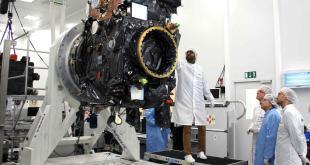 UP42 is reinventing geospatial data by developing a marketplace that brings together service and analytic providers’ services, enabling customers to get the very best out of the plethora of information available to today’s users via a simple interface. Torsten Kriening, COO & Editor, Spacewatch.Global seized the opportunity to sit down and talk with Eli Tamanaha, CEO, UP42 to find out more about this fast-growing company and its future prospects.
UP42 is reinventing geospatial data by developing a marketplace that brings together service and analytic providers’ services, enabling customers to get the very best out of the plethora of information available to today’s users via a simple interface. Torsten Kriening, COO & Editor, Spacewatch.Global seized the opportunity to sit down and talk with Eli Tamanaha, CEO, UP42 to find out more about this fast-growing company and its future prospects.
Can you tell us more about UP42 and what the company is doing?
UP42 is making the use of geospatial data easy. I don’t know if you remember what geospatial data looked like in the 1990s, but I remember it as a map book. It was inefficient and difficult to use and when geospatial data is hard to use, we tend to run away. We just don’t use it and we get lost.
Fast forward to 2019.
Today, when we think about geospatial data we think of Google Maps. I know exactly where I am. It’ll tells me the opening and closing times of all the stores that I want to go to, like restaurants. And in general, it’s just a really, really easy to use interface for geospatial data. When geospatial data is easy to use, we explore. This is the founding premise for UP42.
However, geospatial data is more than just maps, places of interest and routes. It could be very recent satellite imagery that’s taken every day. You can look at infrared, you can look at radar, for example. And it’s not just satellite data either. We also want to combine drone data and traffic data, weather data, IoT data, all different kinds of geospatial data on the same platform. In addition, we want to make it easy for the consumer to use.
The way we do this is to reach out to all the data and analytics providers across the industry. We have started with Airbus, obviously, since Airbus is our parent company, but there are many others such as Planet, because they also have a large constellation of satellites in orbit. We form agreements with them, so that they offer their data on UP42 in exchange for revenue share.
 We have engineered our platform to string together workflows, so that the data can seamlessly flow from a data source into an algorithm or maybe into a second or third algorithm as well. They can then extract that data through a modern API. It’s so easy to use.
We have engineered our platform to string together workflows, so that the data can seamlessly flow from a data source into an algorithm or maybe into a second or third algorithm as well. They can then extract that data through a modern API. It’s so easy to use.
In terms of use cases for UP42, one example is Deutsche Bahn, that maintains the railway tracks in Germany. They need to make sure that trees and bushes don’t get too close to the train tracks because otherwise they could cause accidents. Instead of having a human being walking along the tracks, and just visually inspecting it, they can take a picture from space to measure how close foliage is getting to the tracks.
This is very similar to the LiveEO use case. So, specifically, what is UP42 adding to the business case?
LiveEO is one of our partners and we’re working together in order to discover new use cases for their customers. For example, our easy access to high-resolution Airbus Pleiades satellite imagery and powerful infrastructure enabled LiveEO to determine the height of trees surrounding railway tracks.
Now, LiveEO are able to scale up their solution to cover critical parts of the railway system across Germany. This means that their customer, Deutsche Bahn is tackling the problem of vegetation damage to railway lines by accurately measuring tree height. UP42 has become an integral part of LiveEO’s mission to solve infrastructural problems on Earth from space. We are creating real-world impact.
What makes you unique?
Well, I think that one thing that makes us unique is the fact that we aim to be a true open marketplace. Whereas other models are intended to sell that company’s specific data, what we want to do is to be an open and fair marketplace. So we’re not just trying to sell Airbus data, we’re a neutral marketplace that aims to have a diverse portfolio. We also have competitors’ data on the platform because we want to offer choice. The premise is that by picking and choosing, making everything modular, making everything highly customisable will lower the barrier to entry, and it will allow the customer to experiment more to find solutions that are right for their product.
Can you talk a little more about the structure behind the company? How independent are you?
The company has not been created as an internal team within Airbus. We are incorporated as a separate company within Airbus Defence and Space it so we have the freedom to operate more autonomously this way.
But are you competing with Infoterra or other geospatial data companies?
We aren’t trying to compete with other geospatial data companies. Instead, we see ourselves as a platform and channel to market that others can leverage. Airbus is trying to disambiguate the services they provide and UP42 will be an important part of completing the picture. I think in the future, a lot of Airbus’s solutions will be built on top of the UP42 platform—using data and processing building blocks from Airbus themselves as well as from 3rd parties. We believe that by being able to assemble solutions quickly, using modular blocks from our open marketplace this will drive both speed and innovation in the industry.
Many of the Airbus geospatial data products are based around security, military usage and dual use. Are you trying to appeal mainly to the civilian market?
At this point in time, we are 100% focused on the commercial market. We don’t deal with military or security use cases. Airbus is still serving those sectors, and they’re doing a fine job. We’re going after the civilian commercial market and the potential use cases we can provide solutions to.
What is the business model behind how you engage? Is it a click or picture per time?
UP42´s business model is a straightforward two-sided marketplace, with partners/suppliers on one side and customers/users on the other. We make revenue share agreements with partner companies to put their data and processing blocks on our platform. Our customers then buy credits, which they use when accessing data and analysing it with processing blocks to solve problems. We pay a revenue share to our partners depending on how much our customers used their blocks. Since customers pay for only what they use, it allows us to reach a much broader set of companies than the traditional imagery business. The power of our partnership model is that we ensure that the control of the IP, price, marketing material and licensing terms stay in the hands of our partners. Also, it forces us to truly be an open and neutral marketplace as our success depends on generating money for our partners.
How autonomous are you from Airbus?
It’s a good question. It’s a balancing act to tell the truth because on the one hand, we do leverage a lot of Airbus’s assets. On the other hand, we are located in Berlin, and Airbus team is located in Toulouse, France. So there’s some distance that separates us. We have two Airbus employees in the team and they give us a great connection with the technical and finance side of the company. However, we hire our own employees, we have our own processes, we operate in our own way. Airbus doesn’t really tell me how to operationally run the company.
How big is your team? What are your mid-term and long-term goals?
 Over the last six months, we’ve grown to about 25 people. We will probably grow to 50 people within a year. As you know, we’re located in Berlin. We wanted to be close to Airbus. Airbus has locations in Munich, and Italy and France for the most part so we definitely want to be in Europe. Berlin is also a great source of software engineering talent. There are a lot of start-ups here, too. Also, the cost of living is favourable here. And so we can operate a company on relatively good financial terms. The German government has also been extremely supportive of us.
Over the last six months, we’ve grown to about 25 people. We will probably grow to 50 people within a year. As you know, we’re located in Berlin. We wanted to be close to Airbus. Airbus has locations in Munich, and Italy and France for the most part so we definitely want to be in Europe. Berlin is also a great source of software engineering talent. There are a lot of start-ups here, too. Also, the cost of living is favourable here. And so we can operate a company on relatively good financial terms. The German government has also been extremely supportive of us.
So, as a NewSpace start-up in Berlin, what challenges are you experiencing?
I haven’t seen any political challenges yet and I’m going to knock on wood, and hope that it continues this way. I think that our biggest challenge right now is hiring people, high-quality people at a fast enough pace. Specifically, I’m looking for engineers. We want to get the word out that we are hiring!
So what can we expect from our UP42 in the next year?
Let’s look at the long term first, before bringing it back to where we’ll be in a year. I mentioned Google Maps in the beginning. You and I know Google Maps, because it’s on our phones and for the most part it’s a consumer product. But there’s a whole other side of Google Maps that maybe we are less aware of, which is the Google Maps API. And that powers so many other applications, whether it be web apps, or mobile apps on your phone. It’s like Uber. They have permeated so many businesses out there with their data. I think in the long term, we’ll start seeing a similar thing with UP42 as we lower the barrier to entry and we make it easy for companies to use really powerful geospatial data.
Now that you know our vision, what we’re going to see at least in the next year to two is UP42 on a solid growth path. We’ll have a diverse portfolio of data and processing block providers and become the backbone of building geospatial solutions that have real-world impact. In a year, we’ll be a more recognisable and trusted name in the industry. We’ll be welcoming new customers with questions and partners that can help them to find the answers that they need.
Eli Tamanaha is the CEO of UP42 – the open platform and marketplace to build, run, and scale geospatial solutions. With extended experience in drone services and aerial images, he is an expert in the access to and commercial use of geospatial data. Prior to UP42, he was VP of Strategic Initiatives at PrecisionHawk, a commercial drone and data company. In 2014, Eli founded the company DroneBase, the world’s largest drone service for commercial aerial imagery and data, where he was CTO for over 3 years. Before this, he worked as a software engineer for several tech companies such as Microsoft, Netflix, and Amazon. Eli studied Electrical Engineering, Mathematics, and Japanese at the Brigham Young University in Utah.
SpaceWatch.Global thanks Eli Tamanaha of UP42 for the interview.





